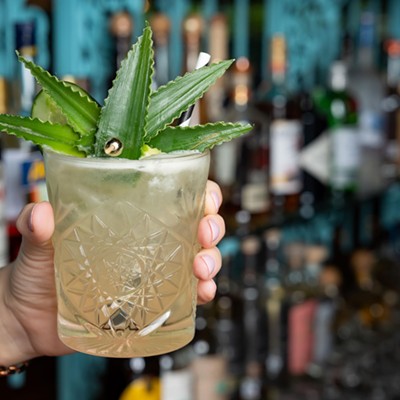It's Divine Reserve release day once again and from the looks of traffic on Twitter, the madness is only growing. Lines were forming early at H-E-B locations as trucks began arriving around 8 a.m.
New to Saint Arnold's Divine Reserve bottling this year are large-format bombers -- which will arrive in stores today -- in addition to the traditional six-packs. The choice on formats is up to you. I prefer six-packs because I can let the beer age varying amounts of time as opposed to having a large single bottle. Another thing to consider with a beer this big is that a 12-ounce serving is probably plenty for two people to share.
On the other hand, large-format bottles are a great buy if you plan to BYOB for dinner out one night or in case you want something to bring to a bottle share.
But enough about that; let's talk beer.
Divine Reserve 13 is a Belgian Quadrupel (or "quad") clocking in at 11 percent A.B.V. Playing off the Belgian Dubbel and Trippel styles, the name Quadrupel actually comes from a specific beer, La Trappe Quadrupel from De Koningshoeven Brewery.
In America, however, Quadrupel refers to an entire style of Belgian Strong Dark Ales. Saint Arnold has their work cut out for them here as this style includes some of the very best-regarded beers in the world, including Westvleteren 12 and one of the beers I am most desperate to get a chance to try, Number of the Beast from Lost Abbey. (Seriously, for the love of all that is evil, hook me up.)
I got ahold of a few bottles of DR 13 this morning amidst the madness of morning queues and rush of Twitter hashtags (#DR13 is the official Twitter hashtag in case you are still on the hunt). And while I do not condone drinking before noon, I am a firm believer in the philosophy of "Do as I say, not as I do." With that in mind, I opened a bottle to get some first thoughts on the newest Saint Arnold brew.
The beer pours a thick deep-brownish red with a thick, light tan head. Upon opening, it has a very strong malty nose followed by plum and toffee and a sharp alcohol finish. Another quick reminder on that alcohol note: This beer is every bit an 11 percent beer, so it's advisable to split it with a friend.
The head is slow to fade and while it doesn't stick to the sides of my glass the way I might have expected a big sticky quad to do, it's lingering a bit.
On tasting, I am conflicted.
What we have here is a beer from Saint Arnold that does something I am glad to see the brewery make a consistent habit of right now: walk the style definition line right down the middle. As we continue to experience the heyday of the newest era of American craft beer, one rule is falling to the wayside more often than I'd like to see happen and that is execution of the basics. If you don't know how to sift flour, stop trying to make those Sex and the City cupcakes you saw on Pinterest. If you don't know how to change the bits on your cordless drill, don't promise your wife a custom closet. And if you can't brew a proper Kolsch or Pale Ale, don't try to sell me a whiskey barrel-aged sour Barleywine.
Divine Reserve does a lot of things right in respect to hitting the key points. The beer is composed and brings the aged fruit and strong candied caramel malt notes I wanted to see in this big Belgian beer. The finish is sharp and quick, lending itself to being drinkable and clean -- even fresh -- given its large body. As with Icon Blue (which we discussed last week), this is another beer with a great nose and the aroma does a lot to tell you exactly what you are going to get.
What I don't like right now is a sharp, slight punch of hop flavor that comes on early and detracts slightly from the fruit and malt as you continue to drink. You get a hint of hop on the nose and it continues through the taste, compromising the body of the beer too much for my taste. This is compounded by the bright carbonation on the finish. The two actively mask those big notes you are hoping for here. As the beer warms, the hops become more apparent, unfortunately, so I recommend this beer at around 50 degrees.
All is not lost, however. While I think Saint Arnold has produced a beer that's perfectly enjoyable today -- and certainly more approachable fresh than the sticky, uncomposed Divine Reserve 9 Pumpkin Stout or the incredibly hot Divine Reserve 12 Old Ale -- I see here a beer that shows the most promise for aging since DR 9. The DR 13 has the strong potential to be remembered as a highlight in the Divine Reserve series. If you can stand to let your bottles sit in the fridge for a while, that hop note [I am probably complaining about too much as it is] should be far more balanced after 12 months, becoming a key benefit rather than a detraction.
See also: - Cellaring 101: The Basics of Storing Beer - Cellaring 102: Three Beers to Drink Now and Save for Later
Make no mistake, this is an enjoyable if somewhat civilized quad from Saint Arnold. But then again, Saint Arnold is nothing if not ever civilized, even when they are brewing double digit-strength beers.
But don't listen to me. I'm the guy drinking a beer at 11 in the morning, what do I know? Go buy some Divine Reserve for yourself and tell us all about what you think here in the comments or find us on Twitter at @eatingourwords.
Follow Eating Our Words on Facebook and on Twitter @EatingOurWords





